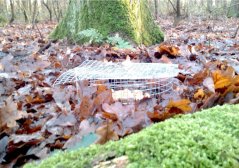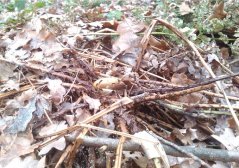
Project
Seed dispersal as a conditional mutualism
Lennart Suselbeek studied how dispersal of acorns by the Wood mouse is affected by the presence of Wild boar and other external circumstances, using seed-fate experiments in the Netherlands. Lennart defended his thesis on 10 October 2014.
Project description
I study how the outcome of a plant-animal interaction is affected by food competition. I will experimentally investigate the role of a seed-hoarding rodent – Wood mouse (Apodemus sylvaticus) – as seed disperser and seed predator of a large-seeded tree species – Pedunculate oak (Quercus robur) – in a multi-trophic system. My hypothesis is that the rodents will behave more as mutualists as they experience more food competition from conspecifics and a third species – Wild boar (Sus scrofa): they will hoard more acorns, and 'scatter-hoard' these in more widely spaced shallow caches with one or few seeds each, some of which will produce seedlings. Under low food competition, in contrast, the rodents will tend to 'larder-hoard' seeds in burrows where all seeds die. To test this hypothesis, I will compare the hoarding behaviour of mice between forests with and without presence of wild boar, and between years with high and low acorn production. I will carry out field experiments at locations in- and outside the Veluwe area in the Netherlands with high populations of wild boar inside the Veluwe and none outside, and do so in multiple years with contrasting seed production. At all locations, I will individually tag acorns with inserted transponders, remotely record acorn removal using camera traps, relocate the dispersed acorns with a customized transponder reader to determine how and where the acorns have been hoarded, and follow acorn fates till death or germination. Four parallel experiments will unravel the factors underlying observed patterns. The results of this study will increase the fundamental insight in the dynamics of species interactions and the circumstances that can influence the outcome of these interactions. Moreover, the results will increase our knowledge on the ecological roles of wood mouse and wild boar, which may contribute to a more sound management of forest and wildlife.
News
- Dutch news article about one of the experiments
- special project blog
- Lennart on television in Klokhuis! (Dutch)
MSc theses
- Snijder, M. A. (2012). Micro-habitat conditions of rodent-dispersed oak seeds; indications for directional hoarding?
- Adamczyk, V. (2011). Effects of hoard distribution and depth on cache pilferage by wild boar (Sus scrofa).
- Jacobs, D. (2011). Effects of wild boar presence on seed removal by wood mice
Related articles


